


At its height, the Aztec capital city of Tenochtitlan was among the largest cities in the world, with perhaps as many as 200,000 inhabitants. In less than 200 years, it evolved from a small settlement on an island in the western swamps of Lake Texcoco into the powerful city it was when the Spanish arrived. Read through the following resources to learn more about this incredible city.
For the Mexica, human sacrifice was key to the health of the world. Recent finds show that a vast rack of skulls stood in a temple at the heart of their capital, Tenochtitlan. This interactive takes you through the temple and talks about the sacrifices performed there and how the skulls of the sacrificed were used in the building.
The priest quickly sliced into the captive's torso and removed his still-beating heart. That sacrifice, one among thousands performed in the sacred city of Tenochtitlan, would feed the gods and ensure the continued existence of the world. Death, however, was just the start of the victim's role in the sacrificial ritual, key to the spiritual world of the Mexica people in the 14th to the 16th centuries. This article talks about the discovery of human skulls in the site of the ancient capital, and what this tells us about ritual sacrifice.
This interactive website gives you the chance to explore some of the features of the impressive Aztec city of Tenochtitlan.
Tenochtitlán was an Aztec city that flourished between A.D. 1325 and 1521. Built on an island on Lake Texcoco, it had a system of canals and causeways that supplied the hundreds of thousands of people who lived there. It was largely destroyed by the Spanish conquistador Hernán Cortés after a siege in 1521, and modern-day Mexico City now lies over much of its remains. This article talks about how the city was founded and some of the areas of importance in the city.
Tenochtitlan was the capital city and centre of the Aztec Empire. It was founded in 1325 and served as the capital until the Aztecs were conquered by Spanish conquistador Hernan Cortes in 1520. This article has a map of the city, and describes some of the design features of the city. It also includes a quick quiz to test your knowledge.
The Templo Mayor or Great Temple (called Hueteocalli by the Aztecs) dominated the central sacred precinct of the Aztec capital Tenochtitlan, which is present-day Mexico City, Mexico. Topped by twin temples dedicated to the war god Huitzilopochtli and the rain god Tlaloc it was a focal point of the Aztec religion and very centre of the Aztec world. It was also the scene of state occasions such as coronations and the place of countless human sacrifices where the blood of the victims was thought to feed and appease the two great gods to whom it was dedicated. This link gives you a 3D view of the temple.
The great temple known as the Templo Mayor of Tenochtitlan symbolizes the axis mundi, the Aztec centre of the world, where the sky, the earth, and the underworld met. According to Aztec worldview, the universe consisted of three layers. The middle layer was the earthly one, inhabited by humans. Above that world, the Aztecs imaged thirteen levels or heavens, Omeyocan, the “place of duality,” being the uppermost. Below the earthly layer, there were the nine levels of the underworld. The lowest of these was the realm of Mictlantecuhtli, the Lord of the Land of the Dead. This article describes how the temple represents these different layers.
When the Aztecs founded their capital, they built a temple. Between 1325 and 1521, each Aztec ruler added a new outermost layer to the temple out of respect to the gods and to ensure that his reign would be immortalized within the great stone structure. This imposing structure lay at the ritual heart of the city. It was here that public rituals, including human sacrifice, took place. Learn more about this temple in this article.

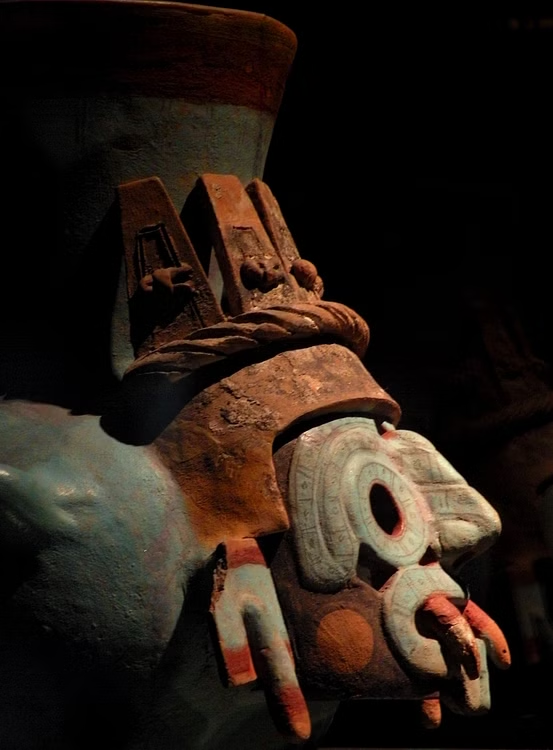
A 15th century CE vase representing the Mesoamerican god of rain, storms and agriculture Tlaloc. From the Templo Mayor in Tenochtitlan. (National Museum of Anthropology, Mexico City).
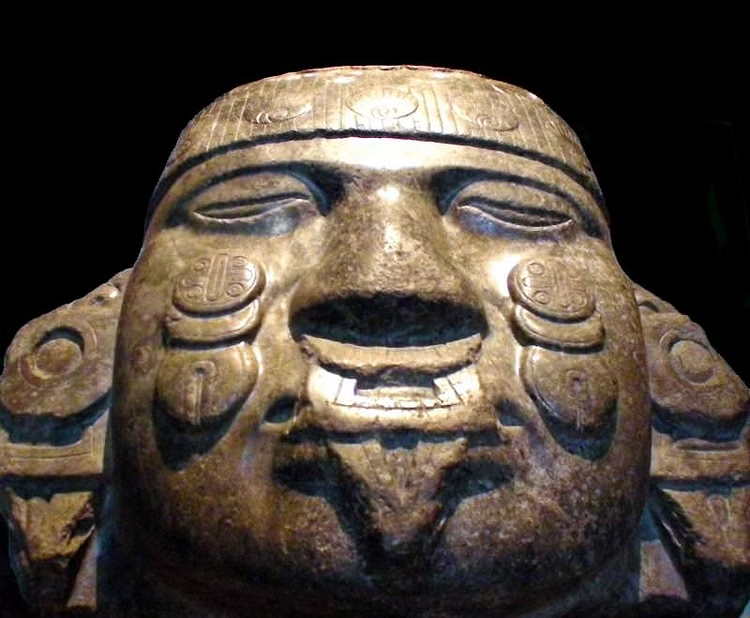
Head of the Aztec Moon goddess Coyolxauhqui. From Tenochtitlan, carved during the reign of Ahuitzotl, 1486-1502 CE. Green diorite. (Museum of Anthropology, Mexico City)
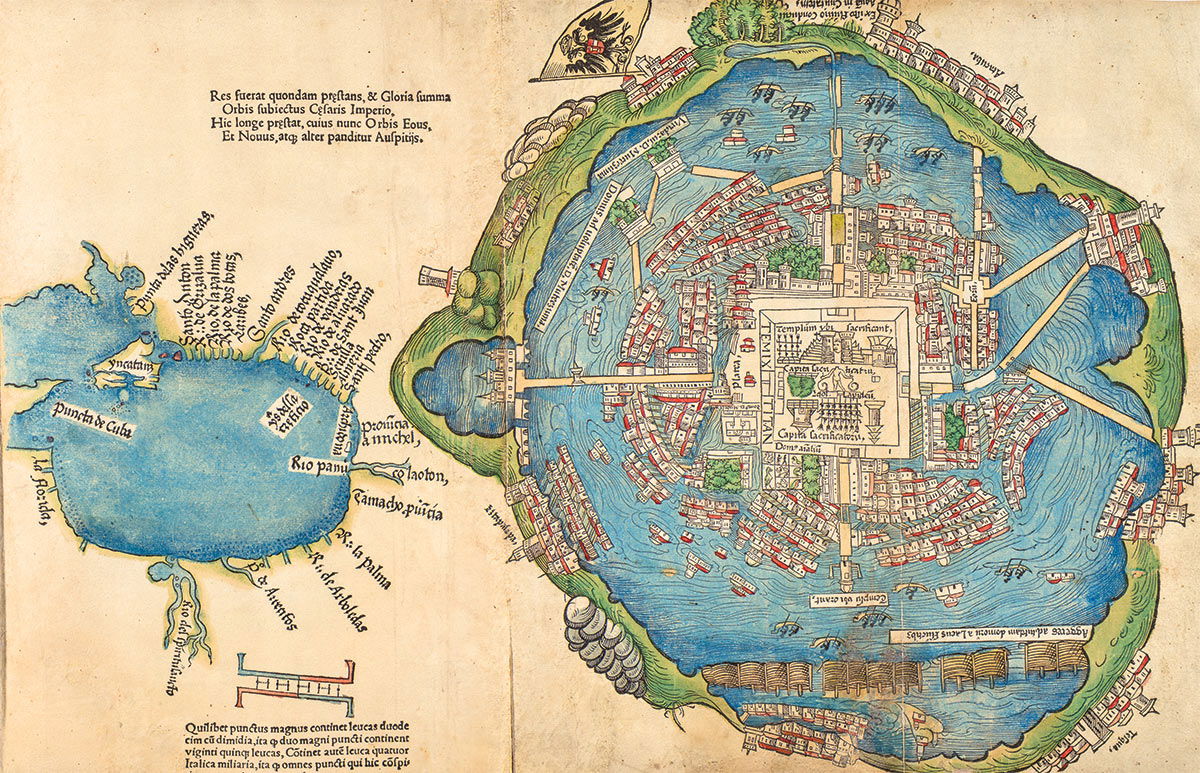
This map, published in Nuremberg in 1524 along with copies of Hernán Cortés’ letters to Emperor Charles V translated into Latin, was the first image seen in Europe of Tenochtitlan, presented under the Habsburg imperial flag. It has been suggested that this, originally, was based on an indigenous map of the city and thus reflects the inhabitants’ own view of it, before being adapted into a woodcut by European craftsmen. Despite being highly stylised, the general design reflects what is known of the layout of Tenochtitlan.
The map is oriented with south at the top. In the centre of Tenochtitlan is the ceremonial precinct, with two towers – the twin sanctuaries to Tlaloc and Huitzilopochtil – framing the rising sun above the Great Temple. Surrounding the ceremonial precinct are the royal palaces, further temples and houses, canals and trees, divided into quarters by four roads. On the left is a representation of the Gulf of Mexico, with Florida on the left and the Yucatan, represented as an island.

This skull wall was unearthed in. the ruins of Templo Mayor, the main temple of Tenochtitlán.


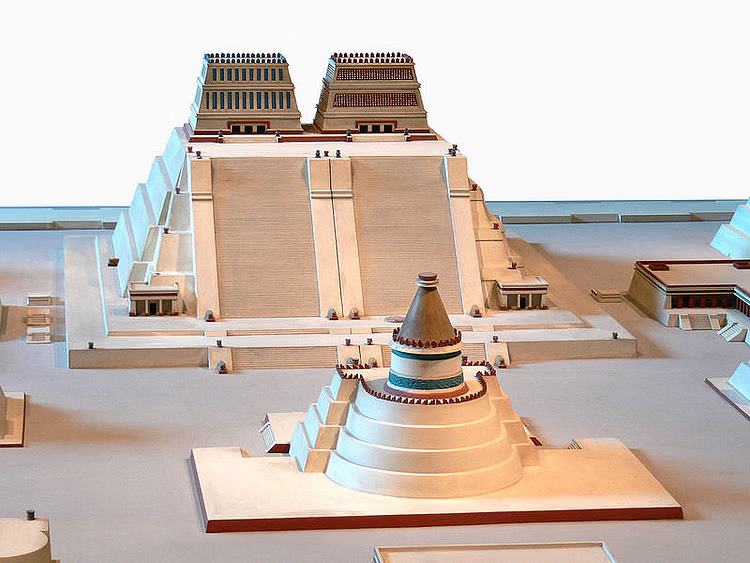
A model reconstruction of the Temple Mayor at the Aztec capital of Tenochtitlan. In use from the 14th to early 16th century CE, the huge pyramid was topped by two temples, one dedicated to Tlaloc, the god of rain (north side), the other to Huitzilopochtli, the god of war (south side). (National Museum of Anthropology, Mexico City).
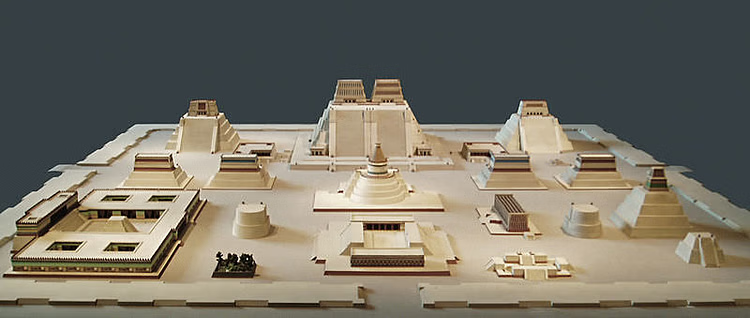
A model reconstruction of the sacred precinct of Tenochtitlan, the Aztec capital on Lake Texcoco. The city was founded in 1345 CE and fell to the Spanish forces led by Cortés in 1521 CE. The sacred complex was dominated by the central pyramid known as the Temple Mayor, dedicated to the gods Tlaloc and Huitzilopochtli. (National Museum of Anthropology, Mexico City).
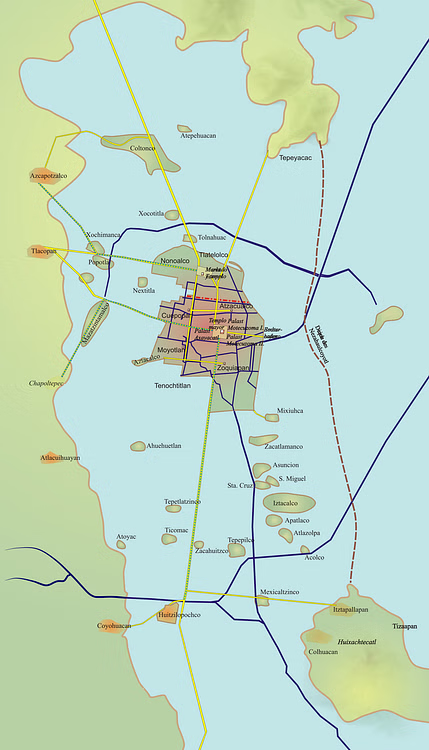
The Aztec capital of Tenochtitlan, located on an island on Lake Texcoco in present-day Mexico. The capital was founded in 1345 CE and destroyed in 1521 CE.